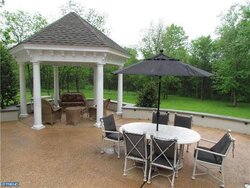One of our patios is concrete, with a pea pebble surface. It was installed ca.1994, and just in the last year has started to show a few hairline cracks. At the moment, they're only noticeable when you really look for them, or after a rain. They stay wet a while, when the rest of the patio has already dried. Seeing how they soak up the water, I imagine that if left alone, it's only a short matter of time before these hairline cracks blow wide open due to winter weather.
In addition to this, the patio seems to get dirty pretty quick. Pressure wash it in April, and it's already showing staining and dirt by July. It seems the concrete has become porous, as if the previous owner had used salt on it in winter.
I imagine there is a sealer that will solve both problems, since I've caught these cracks in the hairline stage. Advice?


In addition to this, the patio seems to get dirty pretty quick. Pressure wash it in April, and it's already showing staining and dirt by July. It seems the concrete has become porous, as if the previous owner had used salt on it in winter.
I imagine there is a sealer that will solve both problems, since I've caught these cracks in the hairline stage. Advice?



